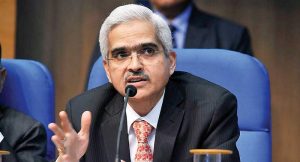
The Monetary Policy Committee of the RBI has kept key policy rates unchanged and decided to continue with the accommodative stance in view of the macroeconomic situation and outlook.
At the policy meeting on Wednesday, the six-member MPC voted unanimously to retain the benchmark repo and reverse repo rates at 4% and 3.35% respectively, and by a majority of 5 to 1 to retain the accommodative policy stance.
RBI Governor Shaktikanta Das stated that the key rates will remain unchanged and the stance will remain accommodative as long as necessary to revive and sustain growth on a durable basis and continue to mitigate the impact of Covid on the economy while ensuring that inflation remains within the target going forward. The marginal standing facility (MSF) rate and the bank rate remain unchanged at 4.25%. The reverse repo rate also remains unchanged at 3.35 %.
The central bank retained its GDP growth projection at 9.5% in FY 2021-22. It is expected that headline inflation will peak in the fourth quarter of the present fiscal and soften thereafter.
Liquidity, Financial Market Conditions
The appearance of the Omicron variant has added to the complexity of the situation even as several economies are still battling the virus while others continue to deal with the lingering scars of Covid.
Several central banks in both advanced and emerging market economies have begun unwinding from crisis-time policies as warranted by their own growth-inflation dynamics. The Reserve Bank will continue to manage liquidity in a manner that is conducive to entrenching the recovery and fostering macroeconomic and financial stability.
The rebalancing followed a pre-announced glide path whereby the variable rate reverse repo (VRRR) auction amount was progressively enhanced to ₹6 trillion by December 3. It is now proposed to enhance the 14-day VRRR auction amounts on a fortnightly basis in the following manner: ₹6.5 trillion on December 17; and further to ₹7.5 trillion on December 31. Consequently, from January 2022 onwards, liquidity absorption will be undertaken mainly through the auction route. Going forward, the main operation of 14-day VRRRs will continue to be complemented by longer-term VRRRs, the size, and maturities of which will be decided on the basis of continuous assessment of the evolving liquidity conditions.
It has now been decided to provide one more option to banks to prepay the outstanding amount of funds availed under the Targeted Long-Term Repo Operations (TLTRO 1.0 and 2.0) announced on 27th March and 17th April, 2020. It may be noted that banks have already prepaid ₹373.48 bn in November 2020, which constituted about one-third of ₹1.12 trillion availed under the scheme. The on-tap liquidity windows of ₹500 bn for ramping up covid related healthcare infrastructure and services and ₹150 bn for certain contact-intensive sectors will continue till their terminal date i.e., March 31, 2022. The MPC proposes to return to the normal dispensation under the MSF. Consequently, banks will be able to dip up to 2% of net demand and time liabilities (NDTL) instead of 3 % for overnight borrowing under the MSF from January 1, 2022.
“We remain committed to our stance in support of our overarching priority at this juncture to broaden the growth impulses while preserving monetary and financial stability. We will also continue to encourage the adequate flow of credit to all productive sectors of the economy,” the RBI Governor said.
Additional Measures
The additional measures are as follows: infusion of capital in overseas branches and subsidiaries of banks and retention/repatriation/transfer of profits by these entities. It has been decided that banks need not seek prior approval of the RBI if they meet the regulatory capital requirements.







